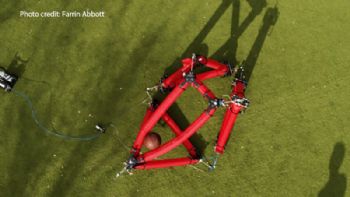
Researchers at California’s Stanford University say that they have developed a new kind of ‘soft robot’ that borrows features from traditional robotics, is safe and has the ability to move and change shape.
Graduate student Nathan Usevitch said: “A significant limitation of most soft robots is that they have to be attached to a bulky air compressor or plugged into a wall, which prevents them from moving.
"We thought, ‘what if we kept the same amount of air in the robot all the time?’ With that as a starting point, we ended up with a human-scale soft robot that can change its shape, allowing it to grab and handle objects and roll in controllable directions.” Their invention is described in a paper that was published in Science Robotics (18 March).
The simplest version of this robot is an inflated tube that runs through three small machines, which ‘pinch’ it into a triangle shape.
One machine holds the two ends of the tube together, while the other two drive along the tube, changing the overall shape of the robot by moving its corners.
The researchers call it an ‘iso-perimetric robot’ because, although the shape changes dramatically, the total length of the edges — and the amount of air inside — remains the same.
Sean Follmer, assistant professor of mechanical engineering (and co-senior author of the paper) (
www.standford.edu), said: “We are basically manipulating a soft structure with traditional motors.
"It makes for a really interesting class of robots that combines many of the benefits of soft robots with all of the knowledge we have about more classic robots; and to make a more complex version of the robot, we simply attach several triangles together.
"By co-ordinating the movements of the different motors, the robot can be made to perform different tasks — such as picking up a ball by engulfing it on three sides — or to roll (by shifting its centre of mass).”
Graduate student Zachary Hammond (co-lead author of the paper) said: “This robot could be really useful for space exploration, particularly as it can be transported in a small package, then operated untethered after it inflates.
“On another planet, it could use its shape-changing ability to traverse complicated environments, squeezing through tight spaces and spreading over obstacles.”